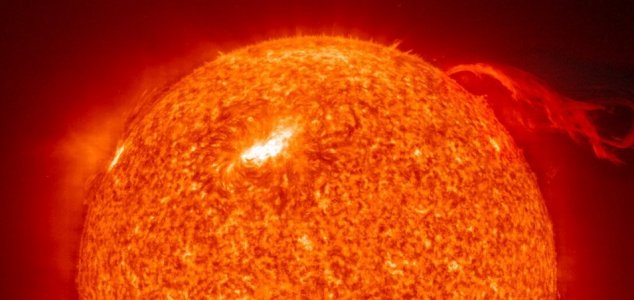Space & Astronomy
May 12, 2014 · 23 comments
23 comments

Our star is not alone. Image Credit: SOHO/EIT
Now thanks to a new technique developed at the University of Texas however it has finally become possible to identify which stars those might be. Ivan Ramirez believes that he has found the first - a star located 110 light years away known as HD 162826.
"We were really just doing this as an experiment," he said. "The fact that we actually found it makes this even cooler." The method involves looking for signs of the chemical composition that all stars from the same stellar nursery share - a 'cosmic DNA' that can help identify them.
The fact that even a single one of the sun's siblings has been found within such close proximity of us is actually quite unexpected. "Estimates of how many we'd be likely to find here in the solar neighborhood have been quite pessimistic," said Ramirez.
Source: TIME | Comments (23)
Sun's long lost sibling has been discovered
By T.K. RandallMay 12, 2014 ·
 23 comments
23 comments
Our star is not alone. Image Credit: SOHO/EIT
A star that formed in the same stellar nursery as our Sun has been discovered 110 light years away.
Stars form not one at a time but in large numbers within huge interstellar clouds of gas and dust. Our own sun is believed to have anywhere up to 10,000 brothers and sisters but over billions of years these have all ended up on different paths to distant parts of the galaxy.Now thanks to a new technique developed at the University of Texas however it has finally become possible to identify which stars those might be. Ivan Ramirez believes that he has found the first - a star located 110 light years away known as HD 162826.
The fact that even a single one of the sun's siblings has been found within such close proximity of us is actually quite unexpected. "Estimates of how many we'd be likely to find here in the solar neighborhood have been quite pessimistic," said Ramirez.
Source: TIME | Comments (23)

The Unexplained Mysteries
Book of Weird News
AVAILABLE NOW
Take a walk on the weird side with this compilation of some of the weirdest stories ever to grace the pages of a newspaper.
Click here to learn more

Support us on Patreon
BONUS CONTENTFor less than the cost of a cup of coffee, you can gain access to a wide range of exclusive perks including our popular 'Lost Ghost Stories' series.
Click here to learn more
Spirituality, Religion and Beliefs
United States and the Americas
Science and Technology
Palaeontology, Archaeology and History
Total Posts: 7,780,163 Topics: 325,676 Members: 203,955
Not a member yet ? Click here to join - registration is free and only takes a moment!
Not a member yet ? Click here to join - registration is free and only takes a moment!





































Please Login or Register to post a comment.